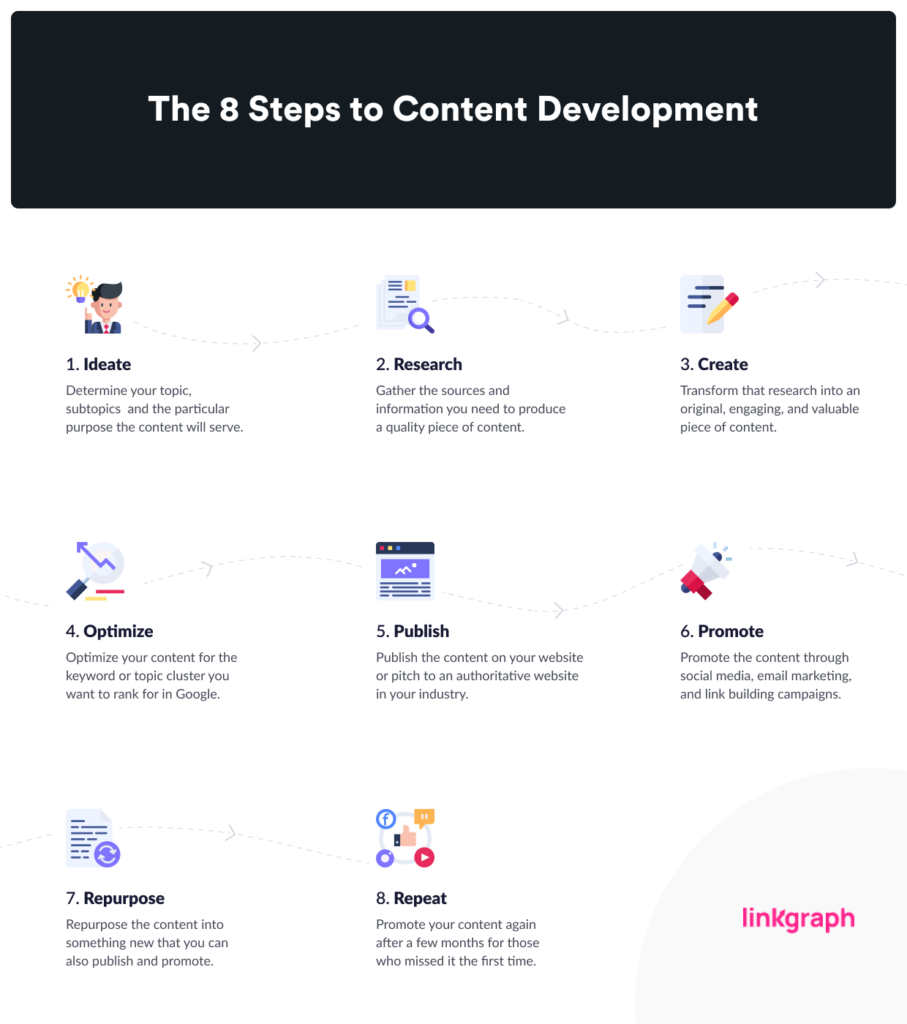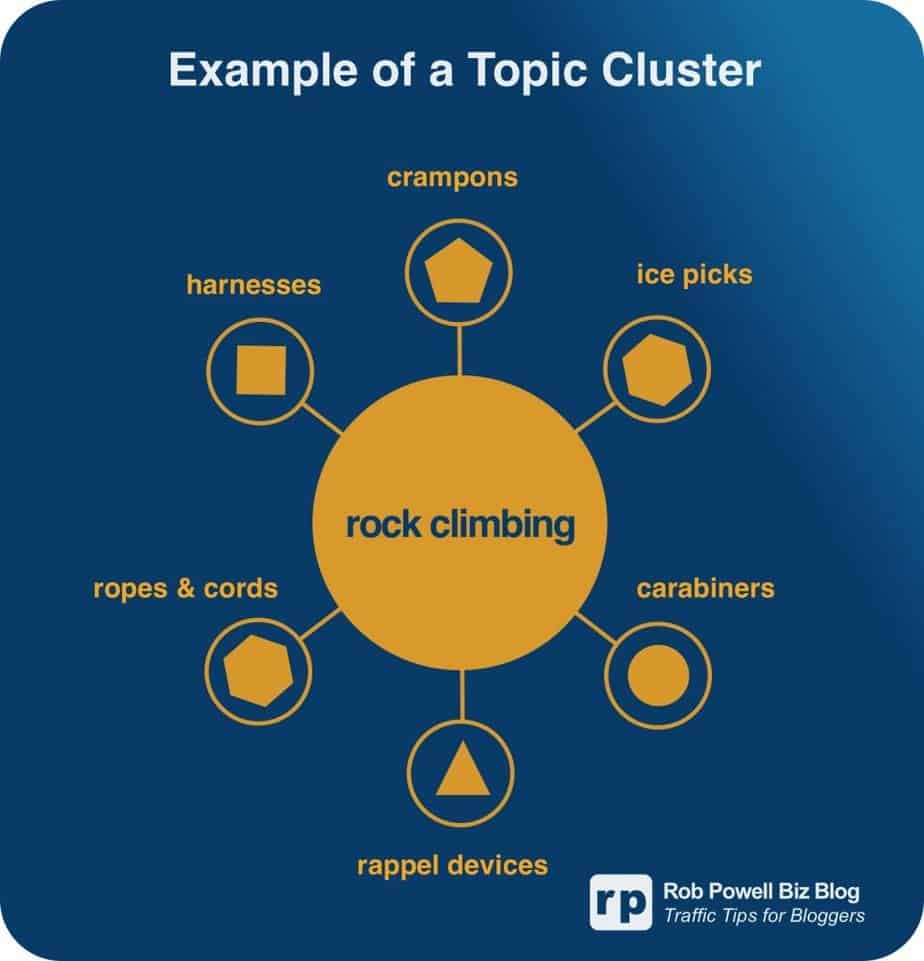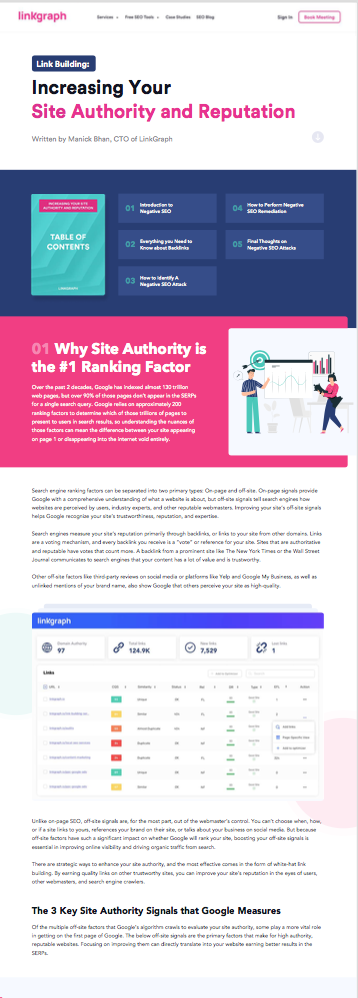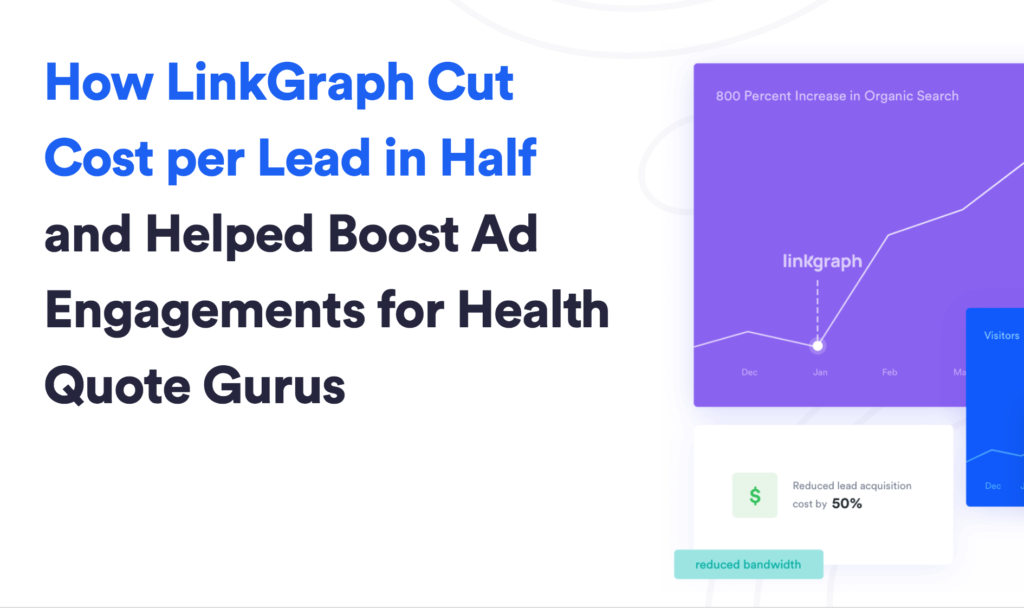Content Development: Improve your Content Strategy for SEO and Achieve Better Results
Content development is an easy way to earn more keyword rankings and customers. Learn how to improve your content development process for SEO.
What are internet users looking for when they use a search engine like Google? Whether they want an expert’s view, an in-depth analysis, a detailed product review, or a quick answer, they are ultimately on the hunt for good information. That’s when content development becomes valuable.
If your company wants to grow its online presence and visibility, there’s no better way to do so than through your content. This means providing great pieces of information to the millions of internet users who are constantly searching for them. After all, when people come across web content they find valuable, they browse, scroll, click, share, and sometimes even link to it.

With 40,000 searches happening on Google every second, the search for content is not going away anytime soon. However, even though there is so much information and content available on the internet, most of it tends to be low-quality and doesn’t even get organic traffic from search engines.
The primary reason for this is that Google’s algorithms prioritize high-quality content and will only show users the best of the best on the internet. So, if you’re a site owner who creates high-quality content, you have endless opportunities to grow your online presence, earn new customers, and reach your business goals.
Web content development is a strategic process that your business can deploy repeatedly. Even better, developing a solid content marketing strategy is more cost-effective than paid media and, when done well, can result in just as many clicks and conversions.
If you have a strong content creation strategy already in place but need help with optimizing the content to rank better in search results, our on-page optimization resources can help. You’ll learn how to improve keyword rankings for your best content assets.
Learn How to Optimize your On-Page Content
Keep reading to learn more about content development and how it can elevate the results of your content SEO strategy.
What is Content Development?
Content development is the process of creating content from start to finish. It may sound simple, but a successful content strategy is informed by data analytics and executed with clear purposes and performance-based goals.
A great piece of content can:
- Provide users with valuable information.
- Rank for relevant keywords.
- Generate engagement on social media sites.
- Guide your website visitors toward conversion.
With its unmatched indexing power, Google dominates the search engine market share and indexes every web page you create for your site. The majority of internet users go to it first when searching for new content.
So, creating content is about appealing to users and the search engine bots that determine those top-ranking results. Google algorithms equip those bots to understand what your content is about and if it’s high quality and relevant to what users enter into their search bar.
There are many ways to establish a content development process, but it will likely depend on the size of your team and the resources available to your brand. A single content writer or strategist will only be able to implement modest planning compared to an SEO or digital marketing agency that has hundreds of content creators.
However, regardless of size, your business needs to have a content development plan. Thinking more strategically about content marketing and optimizing each step of the process can result in thousands of new keyword rankings for your website. This will ultimately lead to increased impressions that might bring more organic traffic, conversions, and revenue.
Content Development and SEO
One of the primary benefits of great web content development is that your content can rank for multiple keywords in search engines. This can expand your market by driving new visitors to your website.
However, Google’s algorithms are constantly being updated and refined, meaning the search engine results page (SERP) results fluctuate. You may have already earned a top-ranking spot for a high-value keyword, but a competitor could soon publish a more comprehensive piece of content on the same topic that Google finds higher quality and starts ranking it above yours.
Google’s crawlers are advanced enough to understand more than just what your content is about. They consider its accuracy, grammar, and the information and comprehensiveness it provides. The page speed, how it visibly looks, and the responsive web design for the user in the internet browser or the type of device they are using are also important for ranking.
Site owners who want to earn traffic from searches consistently have to create new content and update the old so it remains relevant to users. As Google only wants to show the most valuable, useful information, a “set it and forget it” approach to content may work in the short term, but not if you want to drive an audience to your website for years to come.
Creating quality content goes hand-in-hand with SEO in that there’s no point in creating a piece of content without optimizing it. Content marketing efforts bring many SEO benefits. Here are just a few of them:
- Keyword Rankings: Every piece of content you create has the potential to rank for multiple keyword phrases in Google.
- Backlinks: If you create a great piece of content, other webmasters will want to link to it. More backlinks increase your overall site authority, meaning Google will be more inclined to rank content from your domain.
- Conversions: High-quality content can help you drive users to perform a specific conversion action on your website. According to a Hubspot report, websites with more than 40 landing pages increased conversions by over 500%.
- E.A.T.: Google looks for expertise, authority, and trustworthiness. Great content helps display E.A.T. for users and search engine crawlers.
- Site Traffic: If you develop great content on a consistent basis, Google will continue to rank your content, and users will come back to your site again and again
- Brand Awareness: Although more difficult to measure, content that includes your branding, logo, company name, or executive bylines showing up all across the internet helps improve brand recognition and reputation
Having more high-quality content on your site gives Google more reasons to rank your website, which will, in turn, bring all of the above benefits.
Content Development Basics
Don’t just create content without thinking about who will read it, what goals it can accomplish for your business, or what value it brings to users and learners. Content development is all about clear, concrete intentions.
So, for every piece of content you create, you should ask some important questions.
Who Am I Creating This Content For?
Who is the audience engaging with your content? A user who discovers your content in a search engine will have different needs than a previous client who clicks on a content resource shared in an email marketing campaign.
It’s impossible to create content that appeals to every single audience member. Still, you should have a central idea of the target audience to create value based on its needs or preferences, as well as search intent.
What Is My Goal in Writing the Content?
Your content needs to have some type of purpose so you can ultimately measure its value to your brand. Do you want to drive subscribers? Rank for a specific keyword? Get published on a certain website? Having clear, performance-based goals helps you quantify the return on investment and set up an effective call to action on each piece.
You can use tools like Google Analytics to understand how much traffic your content is driving to your website from search. Other important metrics are the click-through rate (CTR), bounce rate, and lead generation numbers.
What Type of Content Am I Creating?
The way that you choose to develop content and its length, from short to long-form articles, will differ based on the accepted rules of the content type. Nothing is worse for the user than an article that doesn’t answer the question set out by the title or an infographic that doesn’t deliver on the visual expectations, don’t you agree?
For a short article, users might prefer a straight-to-the-point approach. For long-form content, it’s important to address major points without sounding repetitive. Every content creator needs to understand the expectations their audience will have for each piece of content type to meet them accordingly.
How Can I Make This Content More Valuable for the User?
We have all seen bad content, right? Nothing turns off a user more than a poorly written article, a poorly designed infographic, or a video tutorial that doesn’t deliver on the promise in the video description. Just publishing content is not enough— it needs to be high-quality.
Google’s webmaster guidelines are very clear about what they consider to be high-quality content. Review them and ask yourself whether or not your existing content assets meet the quality standards set by search engines.
If not, you can’t expect that your publications will magically start ranking. But if you use their guidelines as benchmarks for what every piece of content on your website should look like, there’s a better chance that your content will rank well and often.
The Content Development Process
The content development process can be as short or long as you make it. If you simply want to publish a blog post on your site and never revisit it, that’s fine. However, know that you will miss out on so many opportunities to drive website traffic and conversions.
At LinkGraph, we break down the content cycle into eight essential steps.
- Ideate: Determine your topic, subtopics, audience, content type, and the specific purposes or goals for the content, whether ranking for a particular keyword, generating email addresses or subscribers, getting video views and shares, or some other performance-based goal.
- Research: Gather the sources and information you need to produce a quality piece of content. As you create, include outbound links to the external sources that you reference and internal links to the relevant content that already exists on your website.
- Create: Transform that research into an informative, structured, readable, engaging, and valuable piece of written, visual, audio, or interactive content. Make sure it includes solid information architecture and interactive elements like jump links, rich media, or expandable content modules.
- Optimize: Write your content optimizing for the keyword target you want to rank for. Use a tool like the LinkGraph landing page optimizer to identify relevant focus terms or latent semantic indexing (LSI) terms that Google will see as important to certain phrases. Make sure the content is optimized on the front end and the back end, with HTML tags and technicals like heading tags and meta descriptions. You can also use local SEO strategies to optimize your content to specific locations.
- Publish: Post it on your website or pitch your content to a reputable, authoritative website in your industry niche.
- Promote: Distribute the content through social media channels, email marketing, and link-building campaigns. If your budget allows, you can also use online advertising strategies to drive traffic to your content.
- Repurpose: Find ways to repurpose the content into other pieces of content, whether expanding a blog post into an ebook, creating an infographic from a section of a long-form article, or using clips from your webinar to share as social media posts.
- Repeat: After time has passed, promote your content again to users who may have missed it the first time or now have new reasons to find the content valuable. After 6 months, make sure you update the piece of content with any necessary numbers, figures, or information so it can stay evergreen and meet Google’s content quality signals.
Content Development and On-Page Optimization
Optimization is a necessary step in the content development process if you want your content to rank and accomplish your strategic goals. Here are a few key highlights to keep in mind when thinking about how to improve your overall content development strategy for SEO.
Keyword Targets vs. Topic Clusters
For years, general SEO content creation wisdom has stated that every piece of content on your website should target the specific keywords or search phrases that you want to rank for. This has guided marketing strategies across industries, and most SEO writers still optimize the pieces of content they create for a single keyword target.
This is still an appropriate strategy for sites that want to rank and can be proven successful, but keywords continue to grow more competitive and difficult to rank for. Also, Google crawlers no longer just see the keyword target located in your page titles and heading tags, as they are advanced enough to understand your content semantically.
In addition, Google identifies the various subtopics and long-tail keyword phrases users enter into the search bar that has a close relationship to those primary keywords. For this reason, topic clusters— or content clusters —are a better way to frame your overall SEO content development process.
Think about the primary services that your business offers and that your business has expertise in. Those will form the pillar pages of your website—-most likely a home page, your service pages, category pages, etc).
To form the content cluster, you can create multiple pieces of content that explore subtopics of those primary categories with detail, nuance, and a lot of topical depth. Then, make sure you link back to your primary pillar pages with every new piece of content you create in a cluster.
For example, if you provide financial planning services, your topics of expertise may include stock trading, retirement planning, or family trusts. The content you create for each cluster could include “Best ETFs of the Quarter,” “How to Maintain Your Standard of Living in Retirement,” or “How to Set up a Nevada Asset Protection Trust.” The strategic planning for content creation will be based on keyword research, target audience, user intent, and other aspects.
Here’s a visual example of what topic clustering looks like:
Here’s an example of what those pieces of content may look like in a specific industry:
Topic clusters are a way to think about your content development process for the long term. The search algorithm has changed and grown more complex over the years, but Google’s desire to rank high-quality, authoritative content from experts hasn’t.
Through the strategic use of topic clusters, you can establish your authority and expertise. Therefore, Google associates your brand name not just with a single keyword but with thousands of keyword phrases that are relevant to your field.
Technical SEO
You already saw that for your content to rank in search engines, it needs to be optimized on both the front end and back end, right? This is why good website developers are so important. When it comes down to it, Google is a robot. Making sure the HTML side of your website communicates what your content is about is a way to help it help you.
Uploading an XML sitemap in Google Search Console is also very important as you scale up your content development. The more landing pages and content assets you add to your site, the more important a sitemap becomes so Google crawlers understand which web pages of your domain are the most important.
Continuing in this realm, you should definitely pay attention to the user interface to ensure that your website has a clear and friendly user interface. The web development team, together with UX designers, can work on the user experience design to present your audience with a responsive and visually appealing website.
It’s also necessary to consider what users see in search engines before they click and engage with your content. Metadata like title tags, meta descriptions, URLs, and even features like schema.org markup will change how your SERP results appear visually on the page compared to those of your competitors.
Remember, users won’t get a grasp of the quality of your content until after they have clicked on the SERP result. For this reason, optimize the title tag and meta description so users are encouraged to click.
11 Types of Content Your Brand Should be Creating
There are so many types of content your business can create to use for digital marketing and SEO purposes. Most likely, the types of content you choose will be limited by your team’s resources.
For example, infographics will require a skilled illustrator or graphic designer. Video tutorials might demand quality A/V equipment and video editing software. In general, the ideal content development team will include:
- Content writers.
- UI/UX designers.
- Graphic designers.
- Videographers.
- Illustrators.
- Web developers.
- Software developers.
- Digital PR team.
Thinking creatively about the content you create and producing a variety of content types is more likely to generate the clicks, page views, sessions, and conversions needed to reach your business goals.
Consider the different types of content that your brand can create in your SEO content development process.
1. Blog Posts
Adding a blog to your website is one of the simplest and best ways to start implementing a content marketing strategy and achieving organic search results. Most content management systems (CMS), like WordPress and content marketing platforms, make regularly publishing a blog post simple.
They also have the features to help you add rich media, jump links, or design elements that elevate the overall user experience. If you don’t have a content writer or strategist on your team to create SEO content, a digital marketing agency like LinkGraph can provide blog writing services.
2. Ebooks
In some ways, you can think of an ebook as a long blog post. However, they are more technical and often include design elements that encourage a user to engage with the content for a longer period of time.
Ebooks are meant to be instructional in nature and provide the audience with extensive information on a topic in a specific industry niche. They can also serve as reference sources that other writers want to cite or link the PDF to in their content and, therefore, can be used for link-building campaigns easily.
3. Webinars
When your content team needs a break from all of the writing, you can offer live webinars to your existing leads. They consist of virtual events that allow you to share your knowledge on a topic, position yourself as an authority, and interact with your audience.
Holding a live webinar provides an opportunity to offer a more personalized experience with question-and-answer sessions, demos, or other features. Recording those webinars and putting them on YouTube or a video page on your site means those previous live events become permanent content assets that can drive future organic traffic and conversions.
4. Tutorials
Like webinars, tutorials are video assets that provide instructional value and are often connected to a specific product or service. For B2B and SaaS companies, in particular, tutorial videos can help highlight your product’s unique features and multiple applications.
If you provide software or a business intelligence product, tutorials may be a way to establish your expertise and authority in your vertical and ensure customers get the most from your services. They are also a great alternative to build customer loyalty and encourage email and YouTube subscribers.
5. Infographics
Another engaging visual asset that is great for content marketing purposes is an infographic. They can exist on their own or be paired with blog posts and long-form articles, providing engaging data visualizations and enhancing the user’s readability. Google also loves visual representations of data, and informative, optimized infographics often rank for multiple keywords in Google image searches.
6. Case Studies
Case studies are detailed, data-driven documents that examine how your products or services have produced concrete results for a customer or client. They often follow a “Problem/Solution” structure and show improvements based on metrics and industry-specific KPIs like sales, website traffic, customer-acquisition costs, and more.
Example of a LinkGraph Case Study
7. White Papers/Reports
White papers are similar to ebooks in that they are authoritative, comprehensive explorations of topics. However, they are usually more tied to specific moments in time, current events, or present-day issues (e.g., “Digital Marketing in the time of elections”). They most often include original research or methodology, executive summaries, charts, and graphs and are organized with a top-level structure that makes for easy scanning.
8. Email Marketing Campaigns
Consistently reaching out to your existing customers, leads, and subscribers is a nice strategy to show the value of your products, services, and brand. Emails that are too sales-focused often go unopened, ignored, or unsubscribed. However, using email marketing to make your contact list aware of your content resources–also called information marketing–helps it feel less annoying and more valuable to the audience. Having a newsletter is also interesting for distributing your content.
9. Social Media Posts
Having a consistent social media presence is beneficial for brands of all sizes. Although it’s not as easy to build an organic following as it once was, social media provides another platform through which to share the content that you create and drive traffic to your website. If you run paid media campaigns on social platforms like Facebook or LinkedIn, your advertisements can promote or link to content on your site that provides value to your target audience.
10. Slideshares
Slideshares are visual presentations that can be shared on social media platforms like LinkedIn. Like infographics and webinars, they provide a visual experience for users who respond well to visually engaging experiences.
Your slideshares can focus on many topics, but turning your reports, white papers, webinars, and tutorials into presentations can be a great way to maximize the value of that previous content and present it through a new medium.
11. Podcasts
Another increasingly popular type of content that more brands are creating is podcasts. For B2B and B2C brands, in particular, podcasts help display expertise, highlight the applications of products, and create value-for-value exchanges by featuring other industry experts through interviews or guest speaker opportunities. For better distribution, you should offer your podcast on Apple, Google, Spotify, and other podcast platforms, as well as have a dedicated page on your site for your recent episodes.
Off-site Content That You Should Also Be Creating
On-site content is important to bring traffic to your website and help guide users toward conversion. However, creating content for off-site purposes like reputation management, public relations, and link building is also relevant to your content development strategy.
Off-site content provides you the opportunity to link back to the content assets that live permanently on your site while also elevating your site authority in the eyes of Google. Take a look at some ways to create them!
Guest Posts
Many online publications accept collaboration and guest post submissions from experts in the same industry or field. This is an opportunity to:
- Reach a new audience.
- Earn quality backlinks.
- Develop mutually beneficial relationships with other webmasters.
Site owners are always looking for great content, and if you can provide them with high-quality pieces, it’s considered a win-win for both parties.
Opinion Pieces
Most content marketers prioritize evergreen content because it ranks well in Google for the long term, but the news cycle often brings opportunities for experts to weigh in. Opinion pieces are a way to get published in high-domain authority sites like online newspapers that would otherwise be hard backlinks to acquire. Pay attention to the breakthroughs, stories, and newsworthy events that happen in your industry so you can find the perfect time to weigh in. Using tools like Google Trends can help you stay on top of them.
Insert Manick’s tweet (https://twitter.com/madmanick/status/1320086253803466752)
Tips for Scaling your Content Development Strategy
The scope of your resources and/or team members will ultimately limit your ability to grow your content development. Creating high-quality content is a lot of work, which is why many businesses outsource their content creation to digital marketing or SEO agencies like LinkGraph, which have the infrastructure and resources to produce content at scale.
1. Hire Content Writers and Strategists
If you are just starting to improve your content development plan, adding a full-time content writer or strategist should be one of the first steps. If you cannot bring someone on full-time,
freelance writers can create blogs and on-site content on a part-time or contract basis. Ultimately, you will want a writer who is a skilled researcher who is familiar with your industry and audience and knows how to optimize for SEO.
2 Think Bigger About Your Content Strategy
Every piece of content you create can be repurposed. A blog post about one topic can be expanded into an in-depth ebook. A single concept covered in an ebook can be visualized in an infographic. An infographic can be shared on Instagram or LinkedIn or pitched to other publications in a digital PR campaign.
Still, having duplicate content on your website can result in Google penalties, which is why step 7 in our content development process is called “Repurpose.” Once you create a high-quality piece of content, you can use it as a foundation to create other new types of content that provide similar information or topics but in a different medium or content type.
3. Develop an Editorial Calendar
Getting on a schedule and setting deadlines is essential to scaling your content development process and not being limited to brainstorming ideas. Editorial calendars are publishing schedules that include topics, deadlines, and target keywords and guide the process of creating content across multiple channels.
4. Outsource your Content Development to a Digital Marketing Agency
If you don’t have the resources in-house to operate content development at scale, an SEO and digital marketing agency like LinkGraph can help. With over 1000+ pieces of original content per month, our 50+ editorial team knows the workflow to create content that ranks and to do so on a tight schedule.
Brand new websites that want to grow quickly can benefit from outsourcing the content development strategy, as well as corporations or enterprise-level organizations that need optimized on-site or off-site content at scale.
Nonetheless, regardless of where your content planning currently stands, a site audit can help you pinpoint the areas where your process needs the most improvement.
Remember that content development is one of the most cost-effective ways you can grow your business or brand. If you start investing more time in your content development strategy, you will begin to see the rewards at every level of your organization. And if you’re ready to start scaling up your content strategy, talk to one of our experts.






















































































